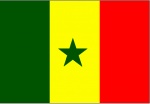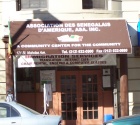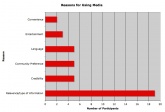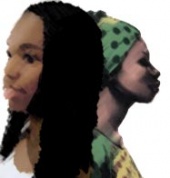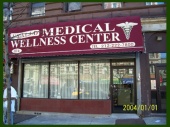Main Page
From The Peopling of New York City

| ||||||||
|---|---|---|---|---|---|---|---|---|

| |
|---|---|
| Methodology
|
| Through reading, we learned about qualitative and quantitative ways to understand immigration to New York City. However, no reading could place us in an immigrant’s shoes. In order to value the past, present, and future identity of New York’s immigrants, we needed to walk the streets of an immigrant community. Encouraged by our professor, we stepped into Little Senegal, located on 116 Street between Frederick Douglas Boulevard and Lenox Avenue.
Although we participated in walking tours of Chinatown and Little Senegal, we needed involvement in something more hands-on and interpersonal. The class organized into teams of two. Each team chose an issue relevant to the West African community, and then dipped their toes into the culture of Harlem. Because our professor had conducted research in Senegal, we were able to use her social capital in building relationships with the community. Our exploration began in Association des Sénégalais d’Amerique, which is an organization designed to ease the burdens of Senegalese immigration. Read More |
A Brief Glimpse of Senegal's HistoryThe country of Senegal spans about 76,000 square miles along the western coast of Africa. To the north are Mauritana and Mali, while Guinea and Guinea-Bissau share Senegal’s southern border. The northern part of the country is mostly savanna, but the southern part, known as the “bread basket” of the country, is forested and has high levels of rainfall. The average temperature ranges from 63 degrees Fahrenheit to 82 degrees Fahrenheit. The capital city of Senegal is Dakar, the western-most point of the African continent. Other major cities are Diourbel, Rufisque, Thies, and Saint Louis.During the 15th century the Portuguese, in search of areas to colonize, were drawn to the coast of West Africa because they wanted to find a harbor to give them access to the interior of the continent, the source of gold and other valued minerals. The Senegal River and the Gambia Estuary provided this easy entrance. This area would later be called ‘Senegal’, which people say is a mispronunciation of the Wolof word, “Sunungal” which means “dugout canoe”. After the Portuguese, the French came to the area and claimed a trading station. Later, between the 17th and 19th centuries, the French took over two islands, St. Louis and Gorée, and established the city of Dakar in 1857. Saint Louis was the first capital. It was considered a prime piece of land because of its location at the mouth of the Senegal River. Read More Culture on 116th Street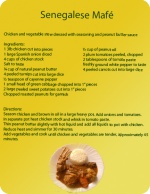 Maffé, a stew made from peanuts, is one of the most popular Senegalese dishes. Other dishes were also available, such as the thiebu-yap, lamb served with rice. The beverages on the menu were also very appealing and exotic. A very popular drink, bissap, is made from the red hibiscus flower; another juice called bui, is made from the fruit of the baobab (in French, pain de singe or ‘monkey bread’). In addition there is ginger juice, guava juice, and mango juice. As we enjoyed our meal, the background was filled with Senegalese music and modern West African rap. Although we didn’t eat out of a bowl with our hands like they do in Senegal, the music and food made for an very authentic experience at Africa Kiné. Read More Organizations on 116th StreetAssistance provided by the ASA comes in many forms. Most of the assistance deals with domestic issues such as domestic violence, problems and divorce. The association also tries to educate the people by giving English and computer training classes as well as providing after school programs for children. For those who need it healthcare questions, such as information about the flu vaccine and access to free medical consultations, and immigrant issues, such as housing, are also covered.We encountered a Senegalese man who ran into the office with a newspaper article. He looked very worried yet excited to find out what the article was about. He gave the article to Kate Newman, a senior at Bard College, who dedicates most of her time to the ASA, volunteering to teach English and Computer Classes, and helping out the Senegalese community. As she began to read, he looked more anxious. Kate smiled and explained what the article was about in French. After learning the content of the article the man looked delighted and surprised and went over to a group of Senegalese men in the office to show them the article. Kate told us that the article was about him, who had an interview with a reporter about the community. In addition, she informed us that many Senegalese who are unable to read English often come to her with bills, articles, letters, and documents. In addition, the ASA organizes cultural activities for the Senegalese community. These activities bond the Senegalese immigrants together and help to reduce the tensions between the Senegalese and other community groups around the 116th Street community. Read More Religion on 116th StreetReligion on 116th can be summed up in two words: Islam and Christianity. The vast majority of the people follow one of the two religions. Most of the immigrants on 116th St. are from francophone West Africa and are Muslims. Though many of the American-born are Christians, there are also many African-American Muslims. The focus of our research was the Senegalese community, so we will look at the Islamic community.For the general investigation, we did research on the Senegalese neighborhood by taking individual tours and by getting acquainted with the Senegalese Association, churches, and Mosques. However, since we were non-Senegalese intruders, we could not initiate immediate field research. Therefore, we decided to learn about Senegal through the Senegalese Association. The times spent at the Senegalese Association were truly fun and inspirational, since all the members treated us like a family. Everyone welcomed us, and while we were enjoying ourselves at the Senegalese Association, we had a privilege of interviewing Mr. Abdou Diaw, who is regarded as a person who is very familiar with religion in the Senegalese community. (He holds religious sessions on Thursday from 10 to 11 PM at WPAT 9:30 AM– Mgontal Mame Diarra, which stands for Evening with Mame Diarra). Read MoreEconomics of 116th StreetBraiding salons have developed a special niche in the African community. These salons provide a large and profitable form of employment for African women. The impact this occupation has had on the status of women has been tremendous. In Africa women are expected to focus all their time on home making and raising children. The husband is the main provider for the family. However, for those women that immigrate to the US, things are very different, they come to the US looking to employment to help their husbands.In the US not only do women find work, in some cases they generate more income than their husbands. Women who work in hair braiding salons especially have an advantage over their husbands in terms of income. Men usually work as vendors selling sunglasses or oils for $5, women working in salons earn $20 for a simple thick braid they make. That’s a big difference, especially when you considered that a single hair design could be over $100. This occupation has given African women status with their husbands and their community. Many women work in the numerous salons that dot not only 116th street but all of Harlem as well. Read More Media on 116th StreetThe African Sun-Times is an English-language newspaper widely distributed in Little Senegal. The paper features content from contributors all over Africa, and is generally devoted to African politics. The paper’s tone is startlingly casual, particularly compared to the strict style guidelines of American journalism, spelling errors are not uncommon. Despite that, the paper contains in-depth coverage of events generally ignored by the mainstream media. Additionally, the paper covers various social and domestic issues of special importance to the listeners, such as religious issues and local ethnic tensions (for example, the tensions between immigrant Africans and African-Americans with ancestral roots in the U.S.)
Le Griot is the major competitor for the Sun-Times’s in the neighborhood, something that should not be ignored. Le Griot is, like the Sun-Times, an African focus paper, but it is written in French. Thus it is more accessible to African immigrants who do not speak English and are more comfortable in Wolof or French, which makes up a large portion of the Senegalese community. While the Sun-Times focuses almost exclusively on politics, Le Griot covers a more traditional range of topics for a newspaper, with regular sections on culture and health. Read More Women & Children of 116th StreetWhether women's greater independence in New York is a good or bad thing depends on who you're asking. Though thanks to the media, the Senegalese people now see some of the positive aspects of America, which they once thought were mostly negative. For example, women in Senegal want to be independent and self-asserting like American woman. But, according to a member of the Association of Senegalese in America located at 121 on 116th Street, "Good women can't [be independent], only bad women can." However, one thing that Senegalese women have in common no matter where they are is that, as Aida said, "women are always doing business or carrying out transactions." atou, a Senegalese-American high school student will tell you the opposite, “Over here there’s less freedom. In Senegal, you can do more of what you want to because everyone knows each other.” Here in America, Fatou's activities are limited because her parents want her to be safe and believe that the streets are dangerous. When school is over for the day, she has only two options, go to soccer practice and then go home or go straight home. Read More Healthcare on 116th StreetThe final difficulty for these West African immigrants may be unfamiliarity with the healthcare system in America. In the U.S., traditional healers are an important part of health care. In many villages, the healers provide as much if not more medical assistance to the ill. Healers practice indigenous medicine which combines science and Divination. They are usually trained by other healers, often family members.In Senegal, the state does not have the money to cover everyone, so many private providers have emerged (link). Churches, for example, provide care for relatively low fees, and people create community insurance where everyone contributes money to a general pool, and when one person is sick, he can dip into that fund to receive treatment. This behavior is indicative of the way networks operate within Little Senegal. If someone cannot produce documentation to be treated at a public facility, members of the community will pool funds in order to pay for private care. Read More |

